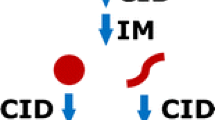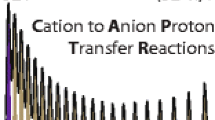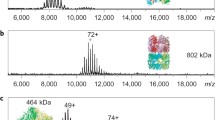Abstract
“Native” mass spectrometry (MS) has been proven to be increasingly useful for structural biology studies of macromolecular assemblies. Using horse liver alcohol dehydrogenase (hADH) and yeast alcohol dehydrogenase (yADH) as examples, we demonstrate that rich information can be obtained in a single native top-down MS experiment using Fourier transform ion cyclotron mass spectrometry (FTICR MS). Beyond measuring the molecular weights of the protein complexes, isotopic mass resolution was achieved for yeast ADH tetramer (147 kDa) with an average resolving power of 412,700 at m/z 5466 in absorption mode, and the mass reflects that each subunit binds to two zinc atoms. The N-terminal 89 amino acid residues were sequenced in a top-down electron capture dissociation (ECD) experiment, along with the identifications of the zinc binding site at Cys46 and a point mutation (V58T). With the combination of various activation/dissociation techniques, including ECD, in-source dissociation (ISD), collisionally activated dissociation (CAD), and infrared multiphoton dissociation (IRMPD), 40% of the yADH sequence was derived directly from the native tetramer complex. For hADH, native top-down ECD-MS shows that both E and S subunits are present in the hADH sample, with a relative ratio of 4:1. Native top-down ISD of the hADH dimer shows that each subunit (E and S chains) binds not only to two zinc atoms, but also the NAD/NADH ligand, with a higher NAD/NADH binding preference for the S chain relative to the E chain. In total, 32% sequence coverage was achieved for both E and S chains.

ᅟ






Similar content being viewed by others
References
van Duijn, E.: Current limitations in native mass spectrometry based structural biology. J. Am. Soc. Mass Spectrom. 21, 971–978 (2010)
Heck, A.J.R.: Native mass spectrometry: a bridge between interactomics and structural biology. Nat. Methods 5, 927–933 (2008)
Sharon, M.: How far can we go with structural mass spectrometry of protein complexes? J. Am. Soc. Mass Spectrom. 21, 487–500 (2010)
Barrera, N.P., Robinson, C.V.: Advances in the mass spectrometry of membrane proteins: From individual proteins to intact complexes. Annu. Rev. Biochem. 80, 247–271 (2011)
Zhou, M., Robinson, C.V.: When proteomics meets structural biology. Trends Biochem. Sci. 35, 522–529 (2010)
Benesch, J.L.P., Robinson, C.V.: Mass spectrometry of macromolecular assemblies: Preservation and dissociation. Curr. Opin. Struct. Biol. 16, 245–251 (2006)
Benesch, J.L.P., Aquilina, J.A., Ruotolo, B.T., Sobott, F., Robinson, C.V.: Tandem mass spectrometry reveals the quaternary organization of macromolecular assemblies. Chem. Biol. 13, 597–605 (2006)
Benesch, J.L.P., Sobott, F., Robinson, C.V.: Thermal dissociation of multimeric protein complexes by using nanoelectrospray mass spectrometry. Anal. Chem. 75, 2208–2214 (2003)
Painter, A.J., Jaya, N., Basha, E., Vierling, E., Robinson, C.V., Benesch, J.L.P.: Real-time monitoring of protein complexes reveals their quaternary organization and dynamics. Chem. Biol. 15, 246–253 (2008)
Lentze, N., Aquilina, J.A., Lindbauer, M., Robinson, C.V., Narberhaus, F.: Temperature and concentration-controlled dynamics of rhizobial small heat shock proteins. Eur. J. Biochem. 271, 2494–2503 (2004)
van Duijn, E., Bakkes, P.J., Heeren, R.M.A., van den Heuvel, R.H.H., van Heerikhuizen, H., van der Vies, S.M., Heck, A.J.R.: Monitoring macromolecular complexes involved in the chaperonin-assisted protein folding cycle by mass spectrometry. Nat. Methods 2, 371–376 (2005)
Snijder, J., Rose, R.J., Veesler, D., Johnson, J.E., Heck, A.J.R.: Studying 18 mDa virus assemblies with native mass spectrometry. Angew. Chem. Int. Ed. 52, 4020–4023 (2013)
Van Berkel, W.J.H., van den Heuvel, R.H.H., Versluis, C., Heck, A.J.R.: Detection of intact megadalton protein assemblies of vanillyl-alcohol oxidase by mass spectrometry. Protein Sci. 9, 435–439 (2000)
Uetrecht, C., Rose, R.J., van Duijn, E., Lorenzen, K., Heck, A.J.R.: Ion mobility mass spectrometry of proteins and protein assemblies. Chem. Soc. Rev. 39, 1633–1655 (2010)
Zhou, M., Jones, C.M., Wysocki, V.H.: Dissecting the large noncovalent protein complex groel with surface-induced dissociation and ion mobility-mass spectrometry. Anal. Chem. 85, 8262–8267 (2013)
Zhou, M., Dagan, S., Wysocki, V.H.: Impact of charge state on gas-phase behaviors of noncovalent protein complexes in collision induced dissociation and surface induced dissociation. Analyst 138, 1353–1362 (2013)
Zhou, M., Dagan, S., Wysocki, V.H.: Protein subunits released by surface collisions of noncovalent complexes: native like compact structures revealed by ion mobility mass spectrometry. Angew. Chem. Int. Ed. 51, 4336–4339 (2012)
Rose, R.J., Damoc, E., Denisov, E., Makarov, A., Heck, A.J.R.: High-sensitivity Orbitrap mass analysis of intact macromolecular assemblies. Nat. Methods 9, 1084–1086 (2012)
Zubarev, R.A., Kelleher, N.L., McLafferty, F.W.: Electron capture dissociation of multiply charged protein cations. A nonergodic process. J. Am. Chem. Soc. 120, 3265–3266 (1998)
Mao, Y., Valeja, S.G., Rouse, J.C., Hendrickson, C.L., Marshall, A.G.: Top-down structural analysis of an intact monoclonal antibody by electron capture dissociation-fourier transform ion cyclotron resonance-mass spectrometry. Anal. Chem. 85, 4239–4246 (2013)
Li, H., Lin, T.-Y., Van Orden, S.L., Zhao, Y., Barrow, M.P., Pizarro, A.M., Qi, Y., Sadler, P.J., O’Connor, P.B.: Use of top-down and bottom-up Fourier transform ion cyclotron resonance mass spectrometry for mapping calmodulin sites modified by platinum anticancer drugs. Anal. Chem. 83, 9507–9515 (2011)
Ge, Y., Rybakova, I.N., Xu, Q., Moss, R.L.: Top-down high-resolution mass spectrometry of cardiac myosin binding protein c revealed that truncation alters protein phosphorylation state. Proc. Natl. Acad. Sci. U.S.A. 106, 12658–12663 (2009)
Breuker, K., Jin, M., Han, X., Jiang, H., McLafferty, F.W.: Top-down identification and characterization of biomolecules by mass spectrometry. J. Am. Soc. Mass Spectrom. 19, 1045–1053 (2008)
Zhang, H., Ge, Y.: Comprehensive analysis of protein modifications by top-down mass spectrometry. Circ. Cardiovasc. Genet. 4, 711 (2011)
Pesavento, J.J., Kim, Y.-B., Taylor, G.K., Kelleher, N.L.: Shotgun annotation of histone modifications: A new approach for streamlined characterization of proteins by top down mass spectrometry. J. Am. Chem. Soc. 126, 3386–3387 (2004)
Fridriksson, E.K., Beavil, A., Holowka, D., Gould, H.J., Baird, B., McLafferty, F.W.: Heterogeneous glycosylation of immunoglobulin e constructs characterized by top-down high-resolution 2-D mass spectrometry. Biochemistry 39, 3369–3376 (2000)
Kelleher, N.L., Taylor, S.V., Grannis, D., Kinsland, C., Chiu, H.-J., Begley, T.P., McLafferty, F.W.: Efficient sequence analysis of the six gene products (7–74 kDa) from the Escherichia coli thiamin biosynthetic operon by tandem high-resolution mass spectrometry. Protein Sci. 7, 1796–1801 (1998)
Ge, Y., Lawhorn, B.G., ElNaggar, M., Strauss, E., Park, J.-H., Begley, T.P., McLafferty, F.W.: Top down characterization of larger proteins (45 kDa) by electron capture dissociation mass spectrometry. J. Am. Chem. Soc. 124, 672–678 (2002)
Wood, T.D., Chen, L.H., Kelleher, N.L., Little, D.P., Kenyon, G.L., McLafferty, F.W.: Direct sequence data from heterogeneous creatine kinase (43 kDa) by high-resolution tandem mass spectrometry. Biochemistry 34, 16251–16254 (1995)
Han, X., Jin, M., Breuker, K., McLafferty, F.W.: Extending top-down mass spectrometry to proteins with masses greater than 200 kDa. Science 314, 109–112 (2006)
Breuker, K., McLafferty, F.W.: Stepwise evolution of protein native structure with electrospray into the gas phase, 10−12 to 102 s. Proc. Natl. Acad. Sci. U.S.A. 105, 18145–18152 (2008)
Schennach, M., Breuker, K.: Proteins with highly similar native folds can show vastly dissimilar folding behavior when desolvated. Angew. Chem. Int. Ed. 53, 164–168 (2014)
Breuker, K., Brüschweiler, S., Tollinger, M.: Electrostatic stabilization of a native protein structure in the gas phase. Angew. Chem. Int. Ed. 50, 873–877 (2011)
Sze, S.K., Ge, Y., Oh, H., McLafferty, F.W.: Top-down mass spectrometry of a 29 kDa protein for characterization of any posttranslational modification to within one residue. Proc. Natl. Acad. Sci. U.S.A. 99, 1774–1779 (2002)
Yin, S., Loo, J.A.: Top-down mass spectrometry of supercharged native protein–ligand complexes. Int. J. Mass Spectrom. 300, 118–122 (2011)
Clarke, D., Murray, E., Hupp, T., Mackay, C.L., Langridge-Smith, P.R.: Mapping a noncovalent protein–peptide interface by top-down FTICR mass spectrometry using electron capture dissociation. J. Am. Soc. Mass Spectrom. 22, 1432–1440 (2011)
Yin, S., Loo, J.A.: Elucidating the site of protein–ATP binding by top-down mass spectrometry. J. Am. Soc. Mass Spectrom. 21, 899–907 (2010)
Xie, Y., Zhang, J., Yin, S., Loo, J.A.: Top-down ESI-ECD-FT-ICR mass spectrometry localizes noncovalent protein–ligand binding sites. J. Am. Chem. Soc. 128, 14432–14433 (2006)
Geels, R.B.J., van der Vies, S.M., Heck, A.J.R., Heeren, R.M.A.: Electron capture dissociation as structural probe for noncovalent gas-phase protein assemblies. Anal. Chem. 78, 7191–7196 (2006)
Zhang, H., Cui, W., Wen, J., Blankenship, R.E., Gross, M.L.: Native electrospray and electron-capture dissociation FTICR mass spectrometry for top-down studies of protein assemblies. Anal. Chem. 83, 5598–5606 (2011)
Zhang, H., Cui, W., Wen, J., Blankenship, R., Gross, M.: Native electrospray and electron-capture dissociation in FTICR mass spectrometry provide top-down sequencing of a protein component in an intact protein assembly. J. Am. Soc. Mass Spectrom. 21, 1966–1968 (2010)
Li, H., Wolff, J.J., Van Orden, S.L., Loo, J.A.: Native top-down electrospray ionization-mass spectrometry of 158 kDa protein complex by high-resolution fourier transform ion cyclotron resonance mass spectrometry. Anal. Chem. 86, 317–320 (2014)
Loo, J.A., Udseth, H.R., Smith, R.D., Futrell, J.H.: Collisional effects on the charge distribution of ions from large molecules, formed by electrospray-ionization mass spectrometry. Rapid Commun. Mass Spectrom. 2, 207–210 (1988)
Loo, J.A., Edmonds, C.G., Smith, R.D.: Tandem mass spectrometry of very large molecules: Serum albumin sequence information from multiply charged ions formed by electrospray ionization. Anal. Chem. 63, 2488–2499 (1991)
Theorell, H.: Structural and Functional Relationships between Isoenzymes of Horse LADH. In: Sund, H. (ed.) Pyridine Nucleotide-Dependent Dehydrogenases, pp. 121–128. Springer-Verlag, Berlin (1970)
Adolph, H.-W., Zwart, P., Meijers, R., Hubatsch, I., Kiefer, M., Lamzin, V., Cedergren-Zeppezauer, E.: Structural basis for substrate specificity differences of horse liver alcohol dehydrogenase isozymes. Biochemistry 39, 12885–12897 (2000)
Gardner, M.W., Brodbelt, J.S.: Impact of proline and aspartic acid residues on the dissociation of intermolecularly crosslinked peptides. J. Am. Soc. Mass Spectrom. 19, 344–357 (2008)
Tsaprailis, G., Somogyi, Á., Nikolaev, E.N., Wysocki, V.H.: Refining the model for selective cleavage at acidic residues in arginine-containing protonated peptides. Int. J. Mass Spectrom. 195/196, 467–479 (2000)
Yu, W., Vath, J.E., Huberty, M.C., Martin, S.A.: Identification of the facile gas-phase cleavage of the Asp-Pro and Asp-Xxx peptide bonds in matrix-assisted laser desorption time-of-flight mass spectrometry. Anal. Chem. 65, 3015–3023 (1993)
Jörnvall, H.: The primary structure of yeast alcohol dehydrogenase. Eur. J. Biochem. 72, 425–442 (1977)
Savitski, M.M., Nielsen, M.L., Zubarev, R.A.: Side-chain losses in electron capture dissociation to improve peptide identification. Anal. Chem. 79, 2296–2302 (2007)
Han, H., Xia, Y., McLuckey, S.A.: Ion trap collisional activation of c and z• ions formed via gas-phase ion/ion electron-transfer dissociation. J. Proteome Res. 6, 3062–3069 (2007)
Dalziel, K.: The purification of nicotinamide adenine dinucleotide and the kinetic effects of nucleotide impurities. J. Biol. Chem. 238, 1538–1543 (1963)
Dickenson, C.J., Dickinson, F.M.: A study of the pH- and temperature-dependence of the reactions of yeast alcohol dehydrogenase with ethanol, acetaldehyde, and butyraldehyde as substrates. Biochem. J. 147, 303–311 (1975)
Al-Karadaghi, S., Cedergren-Zeppezauer, E.S., Hovmoller, S., Petratos, K., Terry, H., Wilson, K.S.: Refined crystal structure of liver alcohol dehydrogenase-nadh complex at 1.8 Å resolution. Acta Crystallogr. Biol. Crystallogr D 50, 793–807 (1994)
Plapp, B.V., Savarimuthu, B.R., Ramaswamy, S.: Asymmetry in a structure of yeast alcohol dehydrogenase. doi:10.2210/pdb2hcy/pdb (to be published)
Cui, W., Rohrs, H.W., Gross, M.L.: Top-down mass spectrometry: Recent developments, applications and perspectives. Analyst 136, 3854–3864 (2011)
Acknowledgments
Support from the US National Institutes of Health (R01 GM103479 and S10 RR028893 to J.A.L.) and the Development and Promotion of Science and Technology Talents Project (DPST), Royal Thai Government (to P.W.) are acknowledged.
Author information
Authors and Affiliations
Corresponding author
Additional information
Special Focus Issue dedicated to the 2013 ASMS Distinguished Contribution Award to Richard D. Smith
Electronic supplementary material
Below is the link to the electronic supplementary material.
Supplementary Figure 1
Native top-down fragmentation sites versus X-ray B-factor of protein complexes. (a) Horse liver ADH and (b) yeast ADH. A-chains are shown in B-factor putty for both structures, and the rest of chains are in cartoon with ECD cleavage sites in red and IRMPD cleavage sites in cyan (PDF 1138 kb)
Rights and permissions
About this article
Cite this article
Li, H., Wongkongkathep, P., Van Orden, S.L. et al. Revealing Ligand Binding Sites and Quantifying Subunit Variants of Noncovalent Protein Complexes in a Single Native Top-Down FTICR MS Experiment. J. Am. Soc. Mass Spectrom. 25, 2060–2068 (2014). https://doi.org/10.1007/s13361-014-0928-6
Received:
Revised:
Accepted:
Published:
Issue Date:
DOI: https://doi.org/10.1007/s13361-014-0928-6




